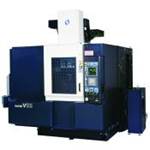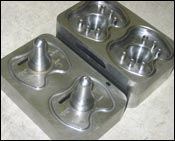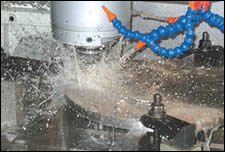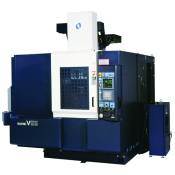VMC for Real-World Moldmaking and Milling
Small moldmaker chooses VMC with unique features—counterbalanced head, box ways, machine design, 3-D accuracy, changeover, control and toolchanger—to improve operations.
SHM is a moldmaking business within a 2,500-square foot facility that specializes in compression, transfer and injection molds for the rubber industry. According to Jack Latragna, owner of SHM, rubber molds are different than plastic molds in that they can be undercut and don’t need slides, so the molds tend to be a little sim-pler. SHM’s molds produce synthetic, elastomer products—silicone, fluorocarbon, gaskets, seals, bellows and diaphragms. SHM is not limited to small molds; they just finished a mold that weighed 500 pounds; a 12" x 8" x 6" military part.
Most recently SHM was machining molds with a couple different vertical machining centers (VMCs). One Latragna decided to sell because the machine had seen its best years, and he needed more capacity, tighter accuracy and repeatability, and greater spindle power.
Machining Molds
He attended the WESTEC trade show in Los Angeles and visited the GBI/Feeler booth—a Cincinnati, OH-based machine tool distributor—which had a VM32SA on the floor taking full horse-power cuts in die steel with ceramic inserts. The VMC wasn’t vibrating or shaking. He thought if this machine can accomplish that feat, it could certainly handle SHM’s work, plus there were a few other features that the Feeler had that many others didn’t.
Counterbalanced Head
An important feature that Latragna was looking for was a mechanically counterbalanced head. Why? Because although the Lake Tahoe area is beautiful, it also is a great source of power anomalies that can interrupt the electrical supply. If there’s a power outage, the VM32SA just stops cutting and the head doesn’t drop; no scrapped part, no broken tool.
Box Ways
When you use a large drill your speeds are fairly low, and the way servos work, without the use of a gearbox, as the speed goes down the torque drops off. Without a gearbox, Feeler has improved the torque on drilling tremendously. However, Latragna was a little concerned about linear guide ways from a dampening point of view. The VM32SA Series has box ways on the Z-axis with linear guides on X and Y axes, which he felt was a good compromise. For drilling Latragna believes they are equivalent, but for milling, the linear guide VMC just shakes, rattles and rolls versus the Feeler, which just cuts.
“I think the Z axis box way is a good compromise for steel cutting machines,” Latragna says. “Box ways dampen vibration, whereas linear guides just don’t.” Latragna doesn’t think rigidity is the real issue with vibration dampening. “When you get chatter, it could be any number of things,” he says. “Sometimes it might be similar to positive feedback in an oscillator circuit. It tends to run away, and the chattering gets worse. The oil between the box way and the sliding members dampens that out entirely. This is well-known in the industry. Linear ways are just a cheaper way to build a machine, and that’s why they’re so popular, plus linear ways allow higher rapid traverse rates. I suppose that’s an issue in production-type work, for which I don’t have any benchmarks. In fact, I just turn the rapids off on the machines and use a high feedrate for “G0” moves—it scares me when we’re doing the first part, and it’s the only part, and the table takes off at 900, 1200, 1500 ipm. I think the Feeler goes 1400 ipm, and that’s too fast for me.”
Machine Design
Latragna notes that the VM32SA design is basically for large parts, but it will run small parts, too. The mold sizes range up to 24" x 24". The Feeler has a 30" x 20" travel, so Latragna can reach almost the entire 24" x 24" plate.
“Oftentimes I will run a mold base, which is like a die set,” Latragna says. “You have match plates, pins, bushings and all of that. I’ll run the bottom on the one machine and the top on the other, and they’ll line up. I have 0.001" clearance between pin and bushing, and we’re holding well within 0.0002" on hole location.
3-D Accuracy
“The other issue is 3-D accuracy; sometimes we have to machine the parting line if we have an odd-shaped line,” Latragna maintains. “You have the A half and the B half, and if your machine is volumetrically inaccurate, they won’t match very well and the mold will flash. It’s very difficult for us to check because I don’t have a 3-D CMM. We have to see if the shape is matching the CAD profile. But if you machine the A and B halves, and you put in a little silicone along the parting lines while you’re assembling, you can see if you have a good match.”
Changeover
Changeover times on the Feeler are measured in minutes rather than hours. SHM doesn’t have any complicated fixturing and usually the parts are in a vice or a set of parallels, bolted directly to the table. Latragna uses 100 percent, off-line programming and often the program is ready-to-go prior to the part being put into the machine. The changeover is very quick, and while the machine’s cutting the part, Latragna will be doing the next program.
“I design for ease of manufacture and for the ability to build the tool in-house accurately and quickly with the machinery we have,” Latragna says. “In most cases, a mold base will come off the Feeler finished. We might possibly have to flip it over on the backside and counter-bore some boltholes, and we just do that on a drill press. Now, if we have a complex cavity—such as a three-way manifold—and it has to be fixtured five times in order to reach every area, you might be inclined to say that I’d need a five-axis mill. Well maybe, but I get a part like that once every five years. Generally speaking, we design the product so we can finish it in one clamping.”
The Control
Latragna says the Feeler Fanuc 0i-MB control has been fine; he does everything off-line. It has a limited amount of internal memory, but a memory card slot is included as standard equipment.
Latragna then just drags and drops the files from the office PC to a PCMICA card. “You plug it in and have programs that are virtually unlimited in length. The Fanuc won’t recognize more than 10,000 lines of code if the code includes line numbers, so you just post it with no line numbers. You can have millions of lines of code.”
Toolchanger
Latragna uses the ATC all of the time. The ATCs on both VMCs are pre-loaded from tools 10 through 21 because the other ATC takes 21 tools max, and the Feeler takes 24. “We’ve got 22, 23, 24 setup for 0.5" dowel pins and bushings,” he notes. “Tools 10-24 are the same cutters all the time. Those are basically for mold base operations: drilling the holes for the leader pins and bushings, boring and milling. I even have an edge finder in tool 20 in both of my machining centers. I just leave it in there, and if I need to pick up an edge, I just call tool 20 and go over and do it.”
Materials
Materials vary depending upon the job. The lower cost tools are made out of an SAE 1045 material that’s sulfurized. The requirements of volume production for the medical field demand stainless. He uses pre-hardened stainless steels in the 400 Class. Also used are pre-hardened chrome moly steels in the 4130, 4140 Class, including P20. And then for Class A tooling, which is heat treated and quenched it’s A2, but more often S7.
More Features
“In addition to the four coolant nozzles that are mounted to the spindle nose, there are four loc-line hoses with little valves that are on the side of the spindle, opposite the toolchanger,” Latragna explains. “The very front one is for a compressed air blast. You call up an M7 code, and you have a compressed air flow from that nozzle. This comes in handy when certain materials and cutter combinations don’t like oil or coolant, and prefer to run dry. If you’re working in a pocket, the air flow keeps the cutter from recutting its own chips.”
Summary
Latragna concludes with his thoughts on SHM's success, “The Feeler has been designed with the touches that are just right for the real world of milling and moldmaking.”
Related Content
Predictive Manufacturing Moves Mold Builder into Advanced Medical Component Manufacturing
From a hot rod hobby, medical molds and shop performance to technology extremes, key relationships and a growth strategy, it’s obvious details matter at Eden Tool.
Read MoreSolving Mold Alignment Problems with the Right Alignment Lock
Correct alignment lock selection can reduce maintenance costs and molding downtime, as well as increase part quality over the mold’s entire life.
Read MoreThe In's and Out's of Ballbar Calibration
This machine tool diagnostic device allows the detection of errors noticeable only while machine tools are in motion.
Read MoreDevelopments in High-Speed Machining Technology
There have been many exciting developments in high-speed machining relative to machining centers and controls, tooling and CAD/CAM systems.
Read MoreRead Next
Technology Partner Is Key to Expanding Moldmaker Capabilities
The past decade has seen significant shifts at R&D Tool, but with a key supplier by its side, they are equipped for new challenges.
Read MoreReasons to Use Fiber Lasers for Mold Cleaning
Fiber lasers offer a simplicity, speed, control and portability, minimizing mold cleaning risks.
Read MoreAre You a Moldmaker Considering 3D Printing? Consider the 3D Printing Workshop at NPE2024
Presentations will cover 3D printing for mold tooling, material innovation, product development, bridge production and full-scale, high-volume additive manufacturing.
Read More.png;maxWidth=970;quality=90)














.jpg;maxWidth=300;quality=90)

.png;maxWidth=300;quality=90)





_300x250 1.png;maxWidth=300;quality=90)











